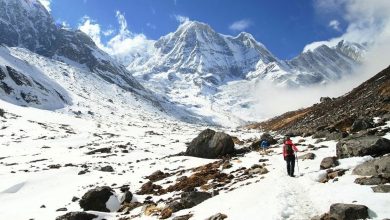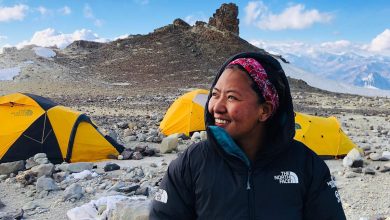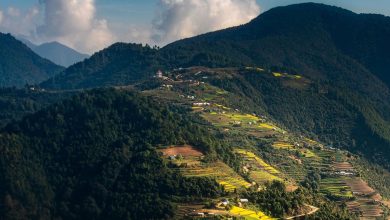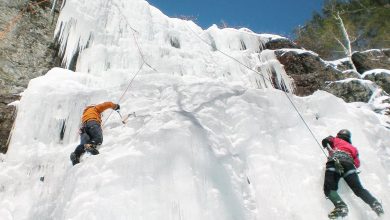Sherpa People: Why Are Sherpas Helpful In Climbing Expeditions?

Sherpa became famous worldwide when Sir Edmund Hillary and Tenzing Norgay Sherpa completed the first-ever summit of Everest on May 29, 1953.
Mt Everest, indeed is a magnificent peak that drives mountaineers from worldwide to its peak. But people need to learn the force and support that enables climbers to physically endure all the challenges to edge up to the peaks like Everest.
We may have heard so much news and stories about sherpas saving the lives of mountaineers, sherpas scaling the peak without an oxygen tank, etc. But who are they?
Sherpa, born mountaineers, is a Nepalese ethnic group and the hidden gem of the Himalayas, numbering around 5,20,000. They are mainly known for their mountaineering skills and ability to thrive in the high-altitude region of Everest and other peaks. Similarly, they are outstanding at their jobs, better than the experienced and trained mountaineers, like acting as porters’ guides, setting up camps at different high elevations, and many more. A yellow brick road is laid yearly for climbers to establish a designated route for the upcoming climbing season.
Today, lets us discuss more about Sherpa people and find out why they are helpful in climbing expedition.
Why Sherpas Make Great Mountaineering Guides?

Sherpa’s Physiological Adaptations for High-Altitude Living
Today, the Sherpa in the Himalayas is the direct offspring of the ancestral people who lived continuously past 25,000 to 40,000 years on the Tibetan plateau. This long exposure to the evolutionary challenges presented by the high altitudes has spurred physiological adaptations.
These physical adaptations enabled the Sherpa people to flourish. The adaptive physiological makeup of the Sherpa can inform on treatments for hypoxia-related illness, including pulmonary, cardiac, neurological, and renal disorders.
Moreover, sherpas physical features are normally different from the average humans at high altitude areas. This being said, scientists have proven that Sherpa produces 30 percent more power than that of the average people of the lowlands. Similarly, Sherpas are thought to possess a higher density of capillaries within each square centimeter of their muscle tissue. Therefore, they rarely suffer from difficulties like AMS and can carry loads double their sizes.
Their strong physical features make them great mountaineering guides.
Sherpa’s Generations of Mountain Skills and Experience
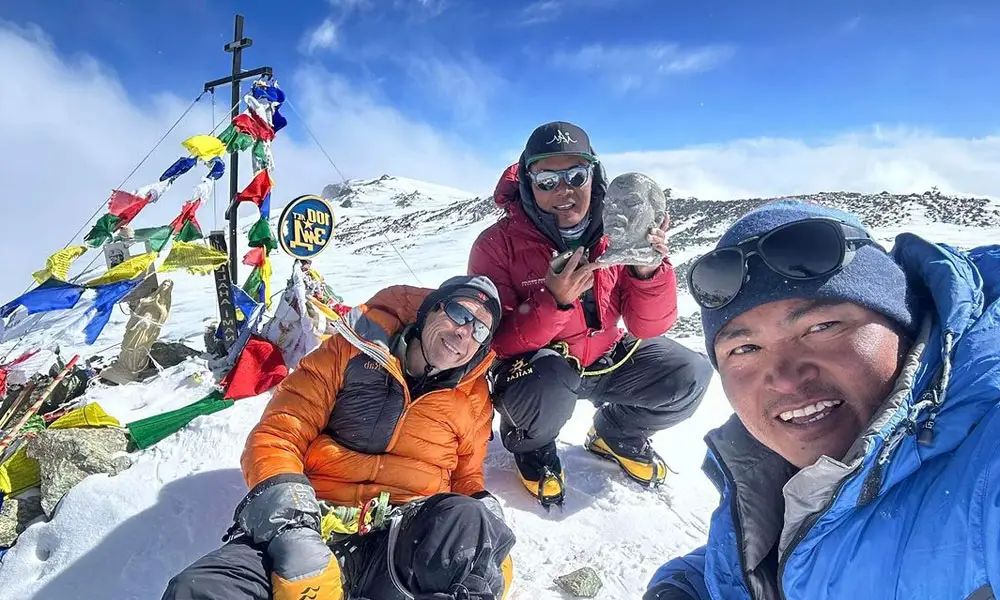
Sherpas are born mountaineers. They have been living in the higher Himalayas area and passing their extensive mountaineering knowledge through their social and cultural traditions to their younger ones. Young Sherpa already has developed the mountaineering skills and experience required for summiting the peaks as they often accompany their parents on high-altitude expeditions from an early age.
Sherpa does get paid to assist the climbers. However, it’s not just the money they climb for; they are also passionate climbers. All these features of Sherpa make them a great mountaineering guide.
Sherpa’s Intimate Knowledge of Himalayan Mountains and Climate
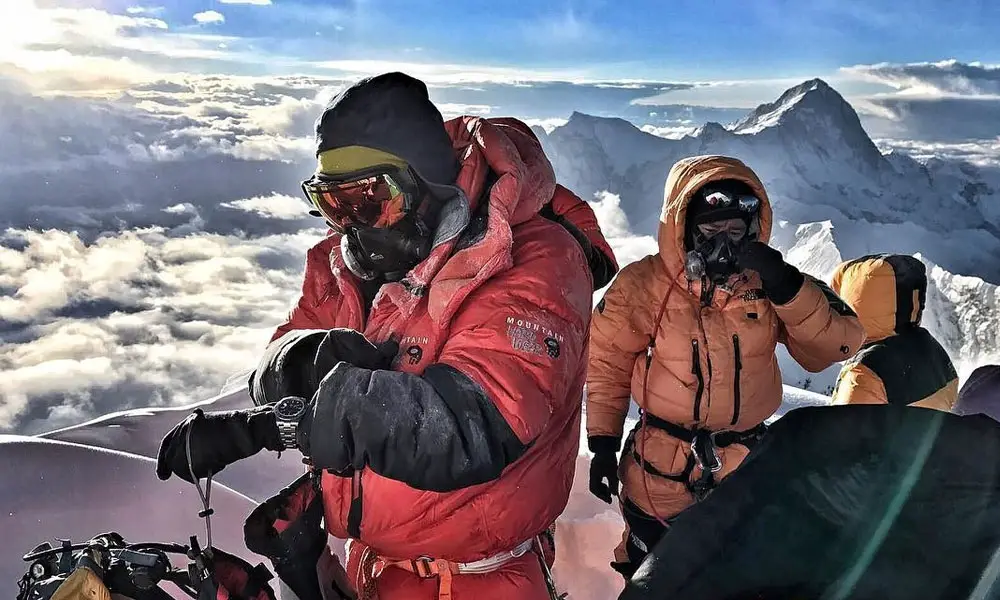
Sherpas are experts in mountainous and have been helping climbers to achieve their lifelong dream of summiting peaks like Everest for generations. They act as your guide, partner, and porter (to carry loads between high and low base camps).
Similarly, they opt for the best and safest way to reach the peak and fix ropes and ladders for you to cross the treacherous passages. They are best at what they do with the help of the knowledge of the mountain and climate they bear.
They are the ones who can foresee the climate changes and the ever-changing weather patterns of the Himalayas. Similarly, they know the mountains like the back of their hand and can even second the signs of catastrophe indications like storms, avalanches, and unexpected climate conditions.
Sherpa Culture: Language and Religion
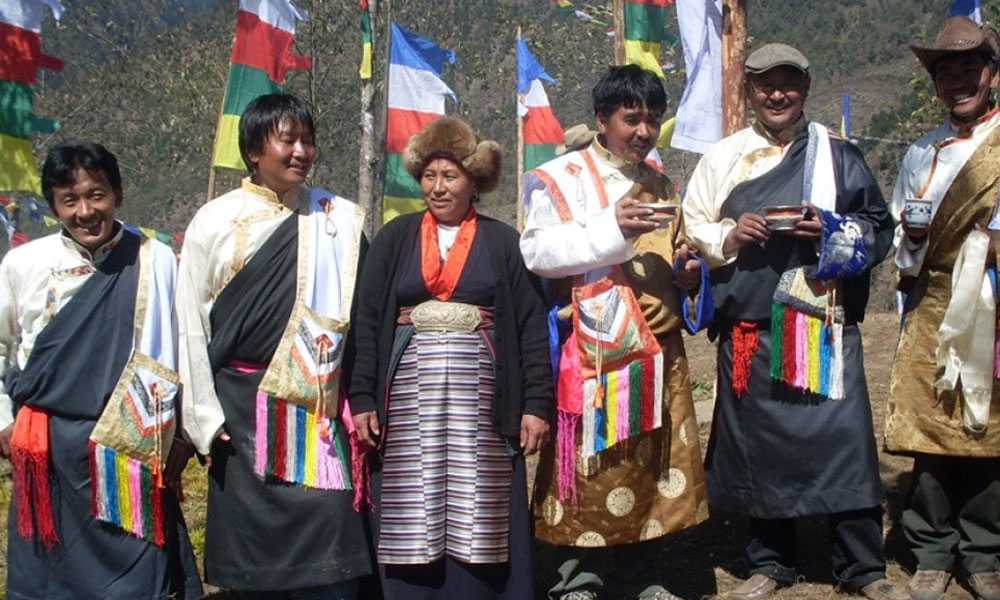
The term Sherpa is derived from the Tibetan language that signifies people who reside in the east. Now, the same term has evolved into referring to the Sherpa community. In Nepal, they are greatly praised as Himalayan athletes and mountaineers.
The main language of the sherpas community is called Sherpa or Sherpali. It’s a Tibetan dialect, as the language of neighboring countries heavily influences it. Similarly, the Sherpa language firmly belongs to the Sino-Tibetan language family of the Tibeto-Burman branch. The Sherpa language is mainly used in Tibetan script writings. Sherpa community also used Nepali to deal with and communicate with locals of the area.
Talking about their religions, the sherpas residing in Nepal are traditionally Tibetan Buddhists belonging to the Nyingmapa sect. This sect is the oldest Buddhist sect that strongly focuses on mysticism and includes elements of shamanistic rituals and local deities adopted from the pre-Buddhist Bon religion.
Also, they have deeply rooted their religious customs in the teachings of the Rongphu monastery. Located nearly 16,000 feet on the northern slopes of Mount Everest, this monastery has played a significant role in shaping its spiritual heritage.
Besides the Nyingmapa sect, some sherpas are also strict followers of the Red Hat sect region, which was named after the monks’ hats’ color at formal occasions. Most of the religious rituals in the community are performed by the monks, or Lamas, who have led an isolated life in search of enlightenment. Similarly, Soothsayers and Shamans are other spiritual leaders of the Sherpa community. These Soothsayers and Shamans mainly deal with the supernatural and spiritual world rather than the religious rituals.
Major Festivals Celebrated in Sherpa Community
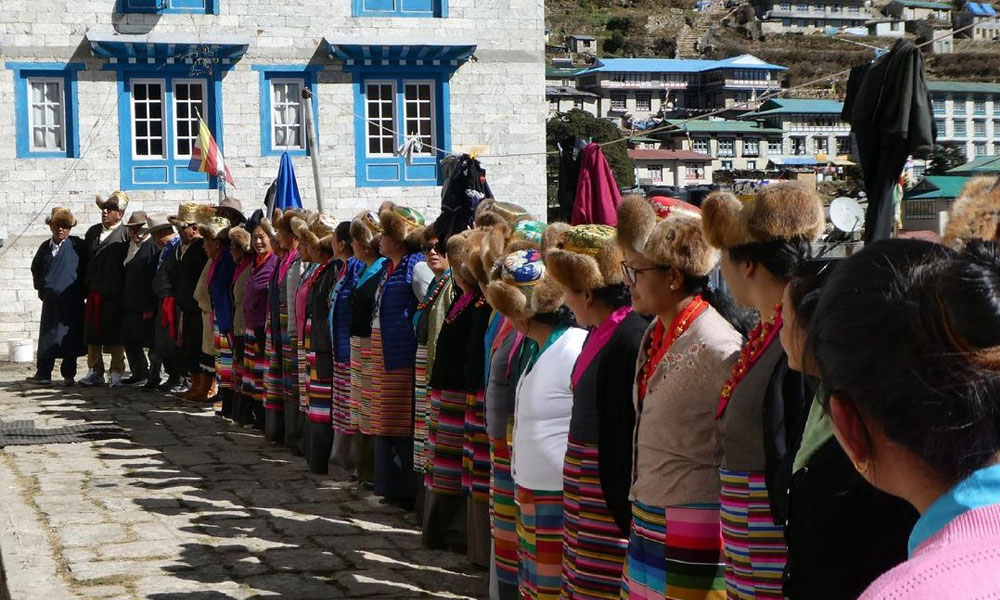
Culture, traditions, religious practices, and rich heritage thrive in the Sherpa community. In fact, the Sherpa people have such strong beliefs that their core belief revolves around the idea that even minor microcosmic alterations can positively impact the world, provided they are executed with mindfulness towards both fellow humans and the environment. Some festivals that Sherpa people joyfully celebrate are Dumje, Losar, and Mani Rimdu. Each of these sherpa festivals is celebrated for several days, showcasing their religious beliefs and a celebration of mutual prosperity.
Loshar (New Year)
Loshar is celebrated as the New Year of the Sherpa people. The main Sherpa New Year is called “Gyalbu-Loshar,” similar to the New Year celebrated by southern and Northern Asian countries like China, Japan, Mongolia, Tibet, etc. All these southern countries are strict followers of Buddhism and have their own ways of celebrating the New Year.
Besides Gyalbu loshar, sherpas celebrate two other Loshar, i.e., Sonam loshar and Tamu Losar. The Loshar festival generally lasts for 15 days, yet the celebration maintains a relatively tranquil atmosphere compared to other festivals of the Sherpa community. During the Lohshar festive time, people clean their houses and pray to their deities for good fortune. Similarly, you will also see dancing, singing, and archery contests during the celebration.
Dumchi and Manirimdu
Dumchi and Manirimdu are two important and biggest festivals celebrated by the Sherpa communities. During the celebration of these festivals, different religious practices and activities like initiations, Nensegphangsum, i.e., trampling, tantric dances, burning, and throwing, are performed.
Dumje is mainly celebrated for the Sherpas’ good health, prosperity, and general welfare. This festival is celebrated in July when the agricultural work has been completed and the trading expeditions to Tibet have returned. The festival is celebrated for over seven days, during which Sherpas visit the monasteries and offer prayers to their gods and deities.
Whereas Mani Rimdu, falling between October and November, typically lasts for 19 days. Among the 19 days, only the last three days are celebrated in Public, while most are spent celebrating the festival with family. If you are on the journey to EBC Trek, you can witness this grand festival and famous masked dancers performing in Tengboche monastery.
The Sherpa Lifestyle
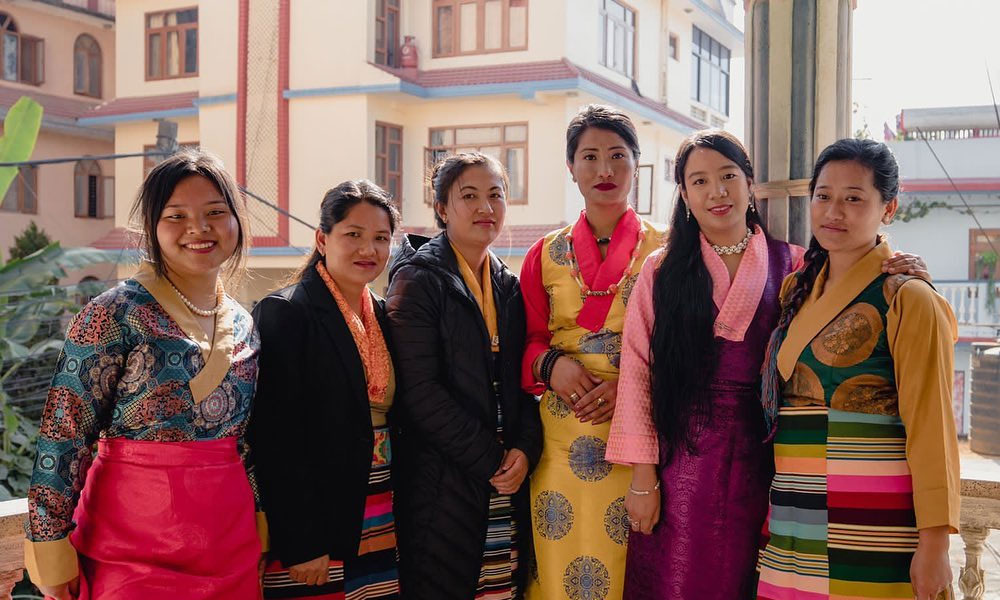
Occupations
Before, sherpa occupations were only centered around agriculture and trade. Later, tourism became a newfound source of income for the locals after foreigners started to visit and explore the Himalayas. This being said, today, most sherpa people work in tourism as guides or mountaineers for trekkers and climbers.
Clothings-
The Sherpa community dress code somewhat resembles the dress code of the Tibetans. They wear thick wool-covered long garments like Bakhu or Kitycow (wraparound robe), a Chhuba to carry the essentials, and a thick outer jacket called Tetung. Traditionally, women adorn themselves in Tongkok, thick woolen dresses, and don colorful striped aprons known as Matils. But the privilege of wearing Matils is only preserved for the married women of the sherpa community.
Similarly, The clothing you find in Western gear is often designed using materials like merino wool, providing hikers with insulated and sustainable clothing suitable for a wide range of adventures.
The most noticeable thing about the Sherpa dress code is the bright colors and the patterns they wear as traditional Sherpa clothing. These patterns on the clothes have their meanings and importance.
Food and Feasts-
Sherpa people mainly consume starchy foods and spices, supplemented by vegetables and occasionally meat as their regular diet. Moreover, the sherpas drink Tibetan tea (tea combined with salt and butter) during every meal and throughout the day.
Their typical breakfast includes Tibetan tea and multiple servings of gruel made from tsampa (roasted flour milk, water, or tea). Sherpa eat their lunch in the late morning, which includes boiled potatoes dipped in the spices. Sometimes, they enjoy eating a stiff dough made of a mixture of grains (sen) with a thin sauce made up of spices, meat, and vegetables as dinner, and sherpas enjoy eating stew (Shakpa), which consists of dough balls, vegetables, and potatoes. Dairy items like butter and yogurt are important in Sherpa foods and feasts.
While Sherpas do consume meat, their devotion to Buddhism prevents them from personally taking the lives of animals for meat.
Famous Sherpa Mountaineers Who Have Made History
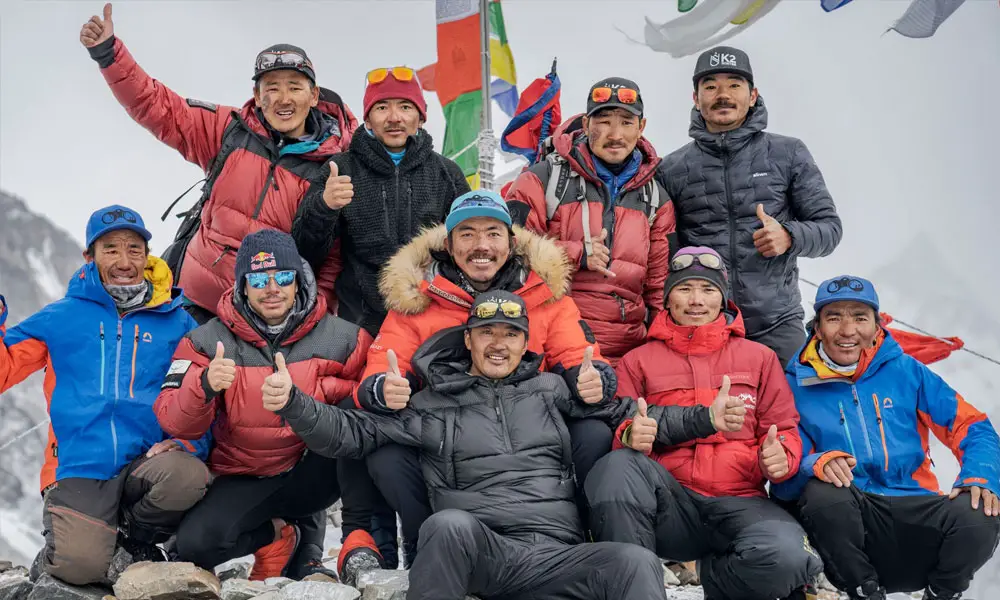
Tenzing Norgay-
No famous mountaineers list can be completed without mentioning the name of the first Everest Summiter- Tenzing Norgay. He is one of the most famous mountaineers in the world who played a great role in the first successful ascent of Everest as a sherpa in 1953.
Tenzing was part of the duo who were the first to scale Mt Everest alongside Sir Edmund Hillary. It was his 4th Everest expedition, but the only time he reached was in 1953 with Edmund Hillary. Following his successful first Everest ascent, Norgay also received Time Magazine recognition as one of the 20th Century’s most influential people. Similarly, India’s most prestigious adventure award was renamed in Tenzing’s honor.
Nirmal Purja:
Nirmal Purja, the star of the Netflix Hit Named ‘14 Peaks – Nothing is Impossible’, is a prominent modern-day sherpa mountaineer.
Purja, a native of Nepal, began his military career with the renowned Gurkha regiment and later served the UK Special Forces with distinction. He is greatly recognized for his achievements and holds a firm place among the mountaineering community and the nation.
After completing his military service, Nirmal Puja, who is now a British citizen, has achieved numerous world records in the Mountaineering community. Similarly, he also earned an MBE in 2018 for his remarkable accomplishments.
Regarding his activities, Puja set the speed record in 2019 for climbing all 14 eight-thousanders within six months and six days. Recently, he was part of the Nepali mountaineers team, successfully making the first Winter ascent of K2.
Kami Rita Sherpa
Kami Rita Sherpa summited Mt Everest at 24 for the first time, but this was just the beginning of this mountaineering career. For the past 28 years, Kami Rita has completed the Everest expedition 25 times. With this remarkable achievement, he holds the record for ascending the most since 2018 and completing his 25th Everest expedition in 2021.
Additionally, he holds an impressive record of conquering 38 summits above 8,000 meters, including formidable peaks like K2, Lhotse, Manaslu, and Cho Oyu.
Pasang Lhamu Sherpa
Pasang Lhamu Sherpa is an inspiration for Nepalese women. She was the first Nepali female climber to reach the summit of Mt Everest successfully. Before her successful ascent on 22 April 1993, Pasang attempted to reach the Everest summit thrice. This shows that with strong determination and hard work, everything is possible. While Pasang’s victory is undeniably inspiring, the story also has a tragic ending as she sadly lost her life during the descent from Mt Everest.
You may also like:
